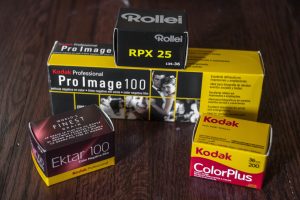There are those who have strong preferences for film over digital and vice versa. I am one of the rare people in the middle that appreciate both pretty equally, but when it comes to sharpness, saturation, and flexibility, digital usually wins for me.
Of course the purpose of film isn’t to always shoot with maximum sharpness or bright and vivid colors, but to get an analog look that has imperfections which can more closely fit the subject of your photograph. One day I got to thinking, how closely can you “fake” an analog look using a digital image and post processing? I had this idea to try an experiment with a digital and film camera, taking pictures of the same thing to see how close I could get.
But then I saw this article in which someone already did this, and with a LOT more effort than I likely ever would put into. This article is actually two years old, originally created by Roy Fochtman and republished this week on EMULSIVE. Talking briefly to Emmett Brown this week, and Emmett says he has asked Roy to see if he would consider creating a Part 2. I’ll keep my fingers crossed that he does!
Here are more great posts from some of my favorite sites:
Somehow I missed this one in last week’s roundup and I couldn’t possibly not mention Theo Panagopoulos’s look at an East German wonder called the Prakti. The Prakti was a scale focus camera with automatic exposure and a motorized film transport. We’ve all heard of Prakticas and Praktiflexes, but now that I know there is also a Prakti, I want one! Gee, thanks Theo!
I’ve almost bought a Diax camera a couple of times over the years, but for one reason or another, it wasn’t meant to be. There’s not a lot of good info out there on this compact interchangeable lens rangefinder, but this week Josh Solomon from Casual Photophile goes over a Diax IIa with a bit of history, some tech stuff, and of course, sample images.
Last fall I reviewed the Kiev 19. A Soviet era 35mm SLR with the specs of a Zenit, in a body the shape of a Pentacon, and using the Nikon F-mount. This week Alan Duncan from Canny Cameras does the same with his take on the Kiev 19. His conclusions are very similar to mine in the sense that his favorite part was the wonderful Helios 81-H lens. You can swap older Nikkor lenses with this camera and vice versa, but once you take away that lens, there’s not a whole lot to say. The title of this review is Part 1, so it’ll be interesting to read what Alan has to say next!
My experience with medium format is mostly limited to folding cameras, or other fully manual models of the mid 20th century. I have yet to handle a modern, electronic MF camera like the Mamiya 6 MF reviewed this week on EMULSIVE, but based on the heaps of praise given to this model by Charlie Tadlock, I think this will be placed on the top of my wish list!
 My favorite color negative film is Portra 160, but my second is Ektar 100. I’ve always thought that the increased vividness of this film is a perfect “in between” film stock that gives a digital look but on film. This week Alex Luyckx adds this wonderful film to his ever growing stockpile of film reviews. Looking at his images, I’m surprised at the lack of over saturation that I often get with Ektar, but his images are nonetheless terrific, as is his analysis.
My favorite color negative film is Portra 160, but my second is Ektar 100. I’ve always thought that the increased vividness of this film is a perfect “in between” film stock that gives a digital look but on film. This week Alex Luyckx adds this wonderful film to his ever growing stockpile of film reviews. Looking at his images, I’m surprised at the lack of over saturation that I often get with Ektar, but his images are nonetheless terrific, as is his analysis.
After seeing the review of Ektar 100 and then Jim Grey’s look at Kodak Color Plus 200, I couldn’t help but muse about the recent order of film I just received from B&H Photo with both Ektar 100 and ColorPlus 200 in it (plus two others). Of the 4 films in the image to the right, I’ve only ever shot Ektar, but am looking forward to the other three. With Jim’s praise of ColorPlus, I can’t wait to try it out!
You’d be forgiven if you’ve never heard of Kodak Linagraph Shellburst film, as this was a military use aerial film only sold in bulk rolls, but this week Mark Faulkner at The GAS Haus shoots this film loaded into a…what? A Kodak disposable camera? Yes, that’s the madness that expired film enthusiast Adam Paul enjoys playing with. Not content to simply roll expired military bulk film into a normal camera, he put it into one of those cheap plastic disposables that you used to see sitting on tables at weddings. I’m going to have to get some of this film for myself!
I have my film development regiment pretty well nailed down, but that doesn’t mean there still isn’t value in seeing what other options are out there. Two years ago, a European company called Ars-Imago announced a Kickstarter campaign to produce a new all in one film development box called the Lab Box. The Lab Box seems to be inspired by the old AGFA Rondinax box which hasn’t been produced in decades, and this week Michael Nguyen from Japan Camera Hunter takes a close look at the new box. How does it work, and is it any good? It’s a bit pricey for me, especially considering I already have my own setup, but Michael’s review really has me considering one.
I’ve previously written my thoughts down on Sunny 16 and what I call the “Outdoor 8 Rule”, but this week Johnny Martyr encourages people like me to expand beyond “guesstimations” of exposure and actually use an external meter on meterless cameras. My resistance to this is mainly convenience, but also, I honestly don’t need perfectly exposed images to write reviews of cameras, but he’s right, perhaps I should up my game and actually take some more readings. Gee, that Voigtländer LED clip on meter does look interesting!
Hell yeah! Planets! As a kid who grew up in the 80s with Star Wars, Star Trek, and the Cold War space race, I am still fascinated with space exploration. The vast numbers of stars and other planets orbiting them in the universe is mind boggling and with technology like the Kepler telescope, we keep discovering more and more of them. But what if some of them had life? There could be real life aliens waiting to greet us like when Zefram Cochran created the first warp drive and the Vulcans detected us and made first contact. Philosophical or religious beliefs aside, it’s just fun to think about. The Trappist system turned out to be a bust, but perhaps these two recently discovered planets orbiting Teegarden’s Star could be the next Tattooine!


